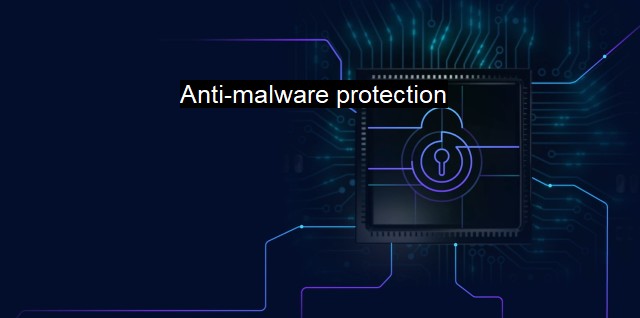What is Anti-malware protection?
The Significance and Evolution of Anti-Malware Protection in Cybersecurity: A Comprehensive Overview
Anti-malware protection is a critical facet of cybersecurity and antivirus strategies in the current digital age. A basic understanding of this particular type of defense mechanism can significantly contribute toward the construction of comprehensive cybersecurity and antivirus strategies within various business and personal realms.Anti-malware protection refers to a range of software that is specifically designed to detect, prevent, and remove malicious software, commonly known as ‘malware.' Its substantive function extends to neutralising other unwelcome software such as spyware, ransomware, trojans and worms. The prefix 'anti' suggests denoting resistance or opposing against, giving anti-malware it's direct significance—protection against malware.
Malware primarily aims to infiltrate, damage or disrupt computers or networks, often committing infractions of varying severity, like financial theft or planting spyware. The comprehensive protection offered by anti-malware can effectively guard, prevent and eliminate such threats, fortifying the cybersecurity infrastructure.
The concept of anti-malware emerged from the persistent dynamic nature of malware. Initially, antivirus programs were entrusted exclusively with the detection and eradication of computer viruses. due to technological advances and increasing interconnectivity, malware types became sophisticated, varied, and more subtle in their operations, thus engendering a demand for a more comprehensive protection strategy.
Anti-malware works pretty much the same way the human immune system does—it detects threats, neutralizes them, and creates a defensive barrier against future infiltrations. It uses a potent methodology of heuristic analysis and signature-based detection mechanisms to prevent malware threats. Heuristic analysis uses behavioral traits and patterns to detect new or modified types of malware that may not be part of the existing virus definitions database. Signature-based detection is advantageous to known threats because it utilises a predefined malware database which helps it identify, and hence counter, known malware types. Together, these methods give anti-malware software the ability to deal with evolving cyber threats innovatively.
Anti-malware protection serves to create cybersecurity shields by scanning incoming user requests and potentially harmful material stemming from various digital channels such as emails, web browsers and files, among other elements. Its action mechanism operates in real-time to safeguard user information from malware by setting automatic scans of devices and data. This mechanism prevents any breach or infraction from taking root in other parts of the network, thus undermining their potentially devastating impact.
Key to understanding anti-malware protection is recognizing the critical role it assumes in securing information infrastructure. This is primarily because malware is always evolving, and thus, defense mechanisms need to change and adapt quickly as well. Cyber threats are often unpredictable; hence anti-malware software essentially becomes the first line of defense between digital resources and potential threats.
The increasing dependence on technology highlights the importance of anti-malware software. As more and more personal, confidential, and economic transactions find themselves enveloped within the digital sphere, the potential for damage multiplies if left unprotected. Consequently, selecting an appropriate anti-malware software and adopting a comprehensive antivirus strategy bears significant ramifications on the survivability and integrity of invaluable data troves.
Even given its steadfast defensive properties, anti-malware should still be combined with firewalls, virtual private networks (VPNs), and additional security mechanisms for robust protection. After all, no single method provides absolute protection. Therefore, anti-malware protection must be part of an extensive cybersecurity strategy.
Anti-malware protection offers an effective mechanism of defense against the constant threat of malware by providing real-time protection, mitigating against new, modified, and existing malware threats. The effectiveness of this tool underscores the imperative of integrating anti-malware software within a more comprehensive cybersecurity plan on both individual and institutional fronts. It is not only a shield that protects valuable digital assets from intrusion, but it is also instrumental in maintaining the integrity and reliability of global information systems.

Anti-malware protection FAQs
What is anti-malware protection, and why is it important for cybersecurity?
Anti-malware protection is a type of software that is designed to detect, prevent, and remove malicious software or malware from a computer system. It's essential for cybersecurity because malware can cause a wide range of problems, including data breaches, theft, and system damage.What types of malware can anti-malware protection software detect?
Anti-malware protection software can detect various types of malware, including viruses, worms, Trojans, ransomware, spyware, adware, and other malicious software. It uses advanced algorithms and behavioral analysis techniques to identify and block potential threats.How can I choose the right anti-malware protection software for my system?
When choosing anti-malware protection software, you should look for features such as real-time scanning, automatic updates, and easy-to-use security tools. It also helps to read reviews and compare different vendors to find software that fits your needs and budget. It's essential to choose reputable software from trusted vendors to ensure maximum protection against malware threats.Can anti-malware protection software guarantee 100% protection against all types of malware?
While anti-malware protection software can provide a high level of protection against malware, it cannot guarantee 100% protection against all types of threats. Cybercriminals are always developing new techniques to evade detection, so it's important to regularly update your anti-malware software and practice safe online behavior (such as avoiding suspicious links, using strong passwords, and keeping software up-to-date) to reduce your risk of malware infections.| | A | | | B | | | C | | | D | | | E | | | F | | | G | | | H | | | I | | | J | | | K | | | L | | | M | |
| | N | | | O | | | P | | | Q | | | R | | | S | | | T | | | U | | | V | | | W | | | X | | | Y | | | Z | |
| | 1 | | | 2 | | | 3 | | | 4 | | | 7 | | | 8 | | |||||||